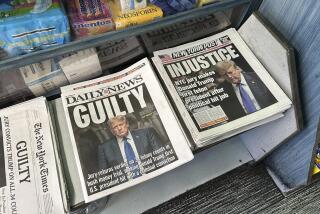The Media See the Light
- Share via
As the turn of the millennium nears, the news business is taking religion more seriously.
Some critics in organized religious groups might suspect that the expanding coverage is driven by sensationalist motives--editors envisioning titillating stories of end-of-the-world religious sects and the like.
Instead, beefed-up news coverage of spiritual matters appears to be a belated response to persistent evidence from opinion surveys and bestseller lists that faith and spiritual pursuits still influence many Americans--despite the prevailing secular tone of public life and culture.
During the 1990s, dozens of newspapers, from the Atlanta Journal-Constitution to the Cleveland Plain Dealer and the Salt Lake City Tribune, have launched weekly religion sections and increased front-page treatment of religious trends and events. The Dallas Morning News set the pace four years ago this month by starting a six-page religion section. The New York Times has two national religion writers in addition to columnist Peter Steinfels.
Recently, the Associated Press, the news wire service that is a chief source of stories for many newspapers across the country, hired two experienced religion writers to replace one who left.
“The executives here, I’m sure, are responding to what’s happening out there and serving the requirements of our clients,” said one of the new AP writers, Richard Ostling, formerly of Time magazine.
The Times has five full-time staff writers assigned to covering religion and spiritual trends in our region and across the country--Larry B. Stammer, Teresa Watanabe, Mary Rourke, Elaine Gale and, starting in a few weeks, Margaret Ramirez, who will focus on religious issues in the region’s rapidly growing Latino community.
Religious Movements Challenge Journalism
Beyond the amount of coverage, newspaper reporting of religion news in the last third of the 20th century has also changed greatly in its content.
When I joined The Times in April of 1967 as a second religion writer--for years afterward this paper was one of the few in the country with two full-time religion specialists--the Saturday religion pages and other designated spots for “church news” were the primary spaces for religion news in most newspapers.
But the global ecumenical movement, the Catholic Church’s historic Second Vatican Council (1962-65) and religious involvement in the civil rights and anti-war struggles of the 1960s challenged journalism’s ability to cover change and controversy swirling about touchy religious issues.
Each year on Christmas, through 1970, the lead editorial in The Times was a portion from the story of Jesus’ birth in the Gospel of Luke. That sort of partiality toward Christianity, which was once common at newspapers, is now a thing of the past.
Similarly, religion reporters at one time focused almost exclusively on established churches and synagogues. But over time, many have found that the more interesting stories were about young, Bible-carrying “Jesus People” groups in Southern California who emboldened previously timid evangelical churches. Or Hasidic rabbis who enlivened or enraged conventional Judaism. Eloquent black pastors called attention to entrenched church racism. Women pushed for ordination as pastors. I covered a well-attended Sunday service in late 1969 of the new Metropolitan Community Church in Hollywood, never thinking that this first congregation for gays and lesbians would become a worldwide denomination within a couple of decades.
Buddhist and Hindu movements began to make their presence known in Southern California. In the late 1980s, Muslim leaders began to give Islam its present prominent role in the region’s vibrant interfaith affairs.
On the national level from the mid-1970s through 1990, when Russell Chandler and I were teamed on the religion beat, the dominant stories concerned the U.S. Catholic bishops, Jerry Falwell and the Moral Majority, the 1987-88 televangelist scandals. Increasingly, religious trend stories quoted not only Christian and Jewish sources, but also those in other faith groups.
Not everyone welcomed the ways in which coverage had changed. Besides contending with growing religious pluralism and liberal-conservative polarization on issues of abortion and homosexuality, many clergy and lay leaders expressed dismay over news coverage of religion. And spiritual explorers only loosely aligned with institutional faith often found much news coverage irrelevant.
Invited to study tensions between religion and the news media in 1992-93 at the First Amendment Center at Vanderbilt University, I concluded in a report with the Rev. Jimmy Allen that the often inadequate coverage of religion resulted from widespread ignorance of a complex subject by news professionals.
Newsrooms’ Uncertain Approach to Religion
Rather than an overt anti-religious bias, we found a reservoir of goodwill in newsrooms--but uncertainty on how to cover such a subtle influence in society.
This uncertainty showed up in new, combined titles given to the religion beat: religion and ethics, faith and philosophy, religion and spirituality, faith and values, etc. I think that religion and spirituality is the best combination; reporting on ethics and values is essential for every news department knowledgeable in its field--from government and business to entertainment and sports.
Numerous forums have called for more sophisticated religion coverage, including a conference in Rome in June that included four ex-presidents of the American Society of Newspaper Editors.
At least two foundations are funding special seminars for journalists new to religion coverage, and the need is growing. Membership in the Religion Newswriters Assn. has hit a high mark of 260 journalists.
“The most telling figure is that nearly a third of them have joined since January of 1997,” said President Gayle White, one of three religion writers at the Atlanta Journal-Constitution.
(BEGIN TEXT OF INFOBOX / INFOGRAPHIC)
Covering Faith
Stories with religious topics have been front page news in major publications during the 1990s. Readers’ changing interests and revolutionary movements among religious believers have changed the way religion is reported.
Map source: Assn. of Statisticians of American Religious Bodies
More to Read
Sign up for Essential California
The most important California stories and recommendations in your inbox every morning.
You may occasionally receive promotional content from the Los Angeles Times.










